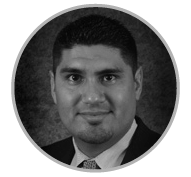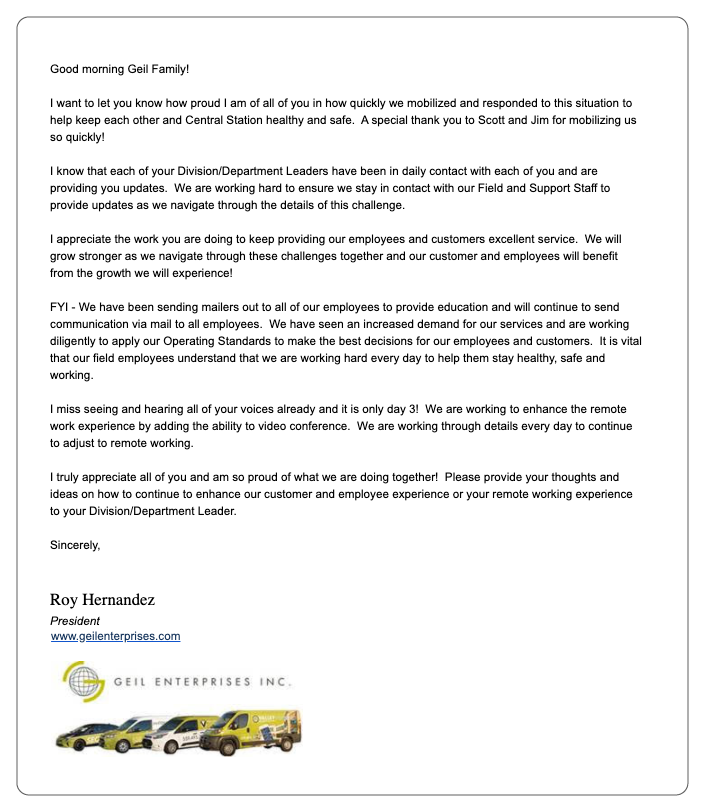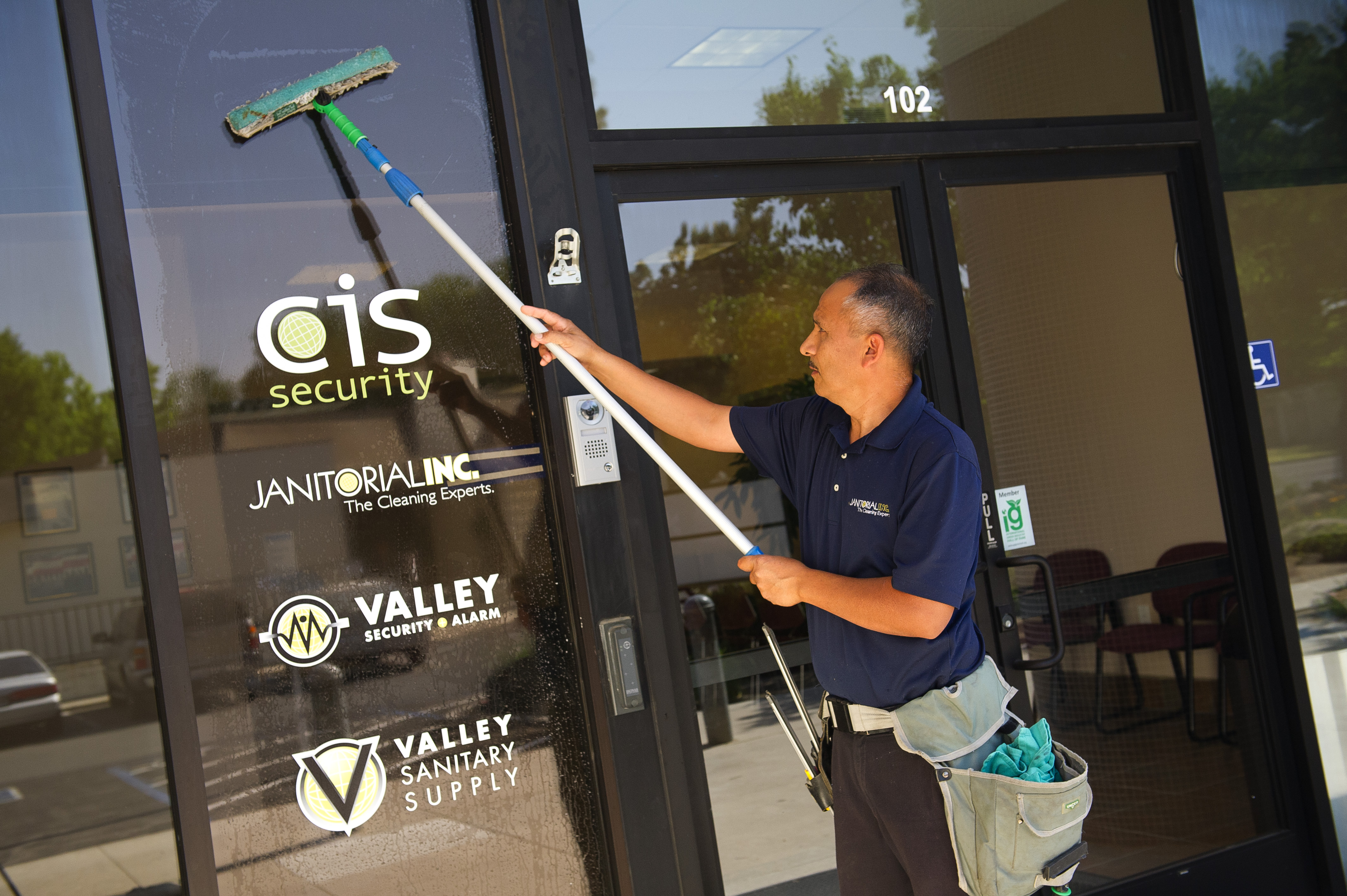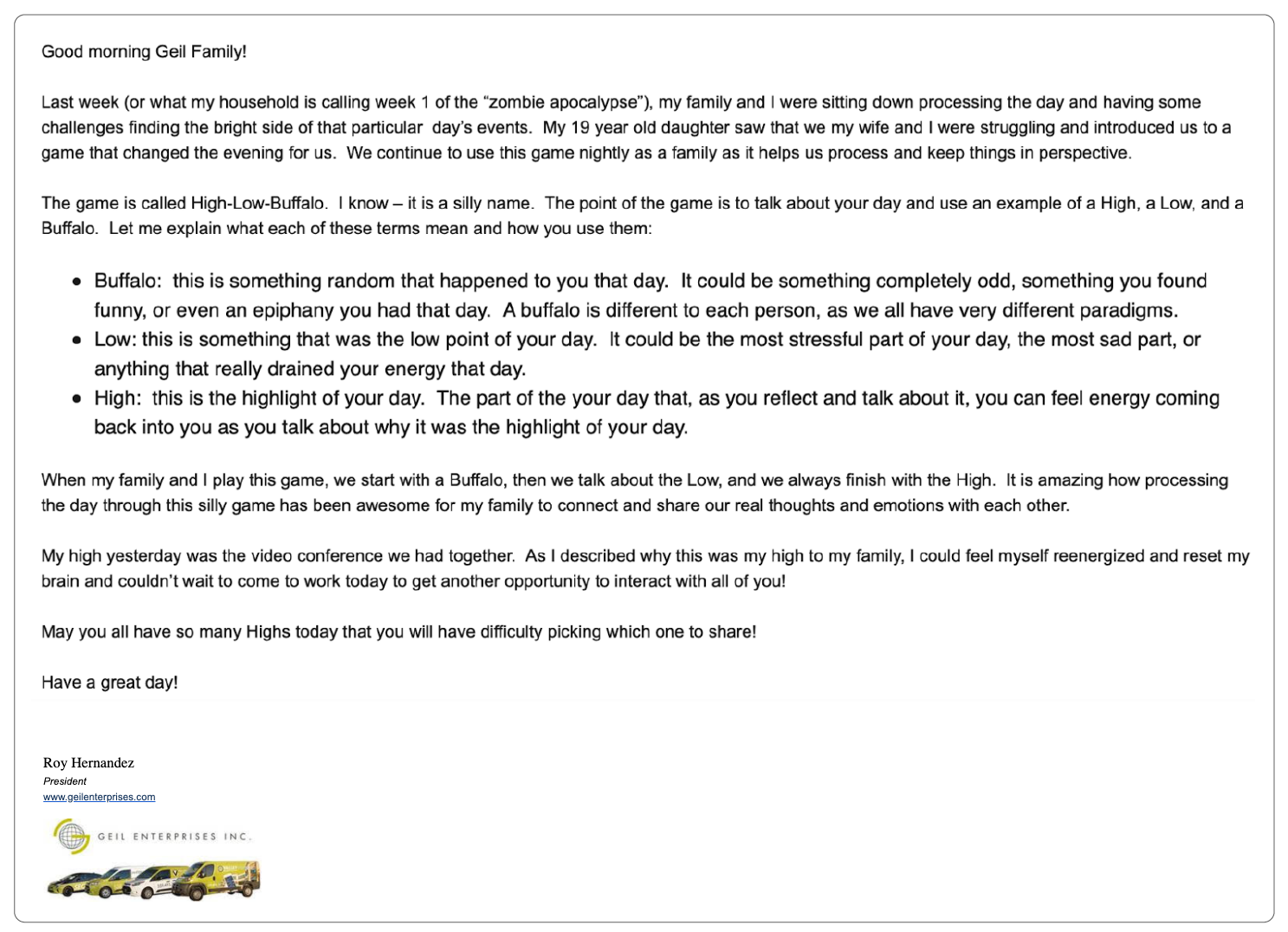Say hello! We’d love to hear from you.
© 2024 Copyright – Small Giants Community. All Rights Reserved

When Roy Hernandez, President of Geil Enterprises, Inc. has a message to get out to his team, it’s more complicated than simply calling an all-hands meeting. Geil Enterprises has four business divisions and 500+ employees out in the field in locations across California. Their employees work in security and alarm, janitorial services and sanitary supplies, all of which are deemed essential businesses. Nearly overnight, their sprawling team of security guards, alarm technicians, janitors, and administrators found themselves on the frontlines of the COVID-19 pandemic. Fear, uncertainty and misinformation took center stage.
“Right away, it became apparent that people were scared of the unknown,” says Roy. “There was so much information floating around and so many assumptions of what the virus would mean for us. People were worried about their jobs, their health, and their safety. I quickly realized that our team members needed information and assurance of what to expect from the organization.”
Roy is traditionally a quiet leader — it’s out of his comfort zone to be the center of attention, and vulnerability is even more uncomfortable. Roy started out with Geil Enterprises in his early twenties, working his way up the ranks from security guard to COO and eventually, he became the first non-family member to serve as president. Prior to enrolling in the Small Giants Leadership Academy, Roy didn’t have any formal leadership training, and that often led to insecurity about his ability to lead.
“I have always struggled to see myself as a leader,” says Roy. “I am a quiet leader who believes in letting others lead and helping them develop. But I’ve been doing a lot of work to build my leadership, and in this moment, I felt compelled to step up and do more.”
It was mid-March, and the news around COVID-19 was changing at breakneck speed. On the evening of March 17, Roy was decompressing at home after the company’s second full day of working remotely. His mind kept returning to his team — how could he meaningfully reach out to the organization during this time? And how could he ensure that company leaders were supporting their teams in the same way?

“I do most of my mental processing and reflection at night,” says Roy. “So I just sat down and started typing out my thoughts. I wanted to send a positive message and show my appreciation for them. It was a bit outside of my comfort zone — but the next morning, I decided to send it anyway.”

The response was overwhelming. It still brings Roy to tears thinking about the outpouring of support and appreciation that followed. His message resonated, but more than anything, it was clear that what his team really needed was to hear from him. It became the first of a daily email series called “Good Morning from RH.”
From that moment on, Roy committed to becoming the voice of the organization, and he was no longer hesitant to be vulnerable and authentic with his team. With each message, he became more vulnerable and open with them, sharing aspects of his home life and his own personal reflections on the global pandemic. At a critical time, it inspired the team to band together instead of splitting apart. Now, he and other company leaders are committed to sharing information, educating the team, and reinforcing their culture on a daily basis.

“It’s allowed me to get out of my comfort zone and grow,” says Roy. “Every day, I transparently share my experience with the team and how I am processing the changes around us. It has set off a chain reaction of people sending positive messages to the group and offering support to one another.”
It was clear that what his team really needed was to hear from him.
Vulnerability is a crucial leadership skill, and behind-the-scenes, Roy has been doing the work to develop as a leader. He’s halfway through the Small Giants Leadership Academy, and it’s helping him build his confidence as a leader. He’s defined his personal leadership mission and values, and he has a deeper understanding of his own leadership style. When it came time for him to show up for his team, he was prepared.
“What has been reinforced to me through this time is that being a leader is not a title,” says Roy. “It is about stepping up when others need you, having a higher purpose than yourself, and giving to others. I have never come closer to my personal mission statement than now: Create positive experiences for myself and others.”
These leaders are part of Small Giants companies — companies that prioritize their purpose and culture and invest in their emerging leaders.
One way Small Giants companies invest in their next generation of leaders is by enrolling them in the Small Giants Leadership Academy. This robust one-year certification program consists of virtual learning sessions with expert leaders and coaches, an extensive resource library, on-the-ground meetups with your cohort, a leadership assessment, and your event ticket to two Small Giants gatherings.
© 2024 Copyright – Small Giants Community. All Rights Reserved
Small Giants Community Program Director
Virtual Position
The Small Giants Community is hiring! Are you looking for a job where you get to work remotely with a hard-working, tight-knit team? Do you like talking about values-based businesses, inspiring leadership stories, and Ted Lasso? Boy, do we have the job for you!
We’re a high-performing team working hard to grow the Small Giants Community, an organization committed to identifying, connecting, and developing purpose-driven business leaders. Our network spans more than 6,000 leaders, 300 companies, and 28,000 employees who are growing with intention, and we believe that more and more people are beginning to see the value in purpose-driven business.
Basically, we’re a small but mighty team. We’re energized by coffee, the sun and leaders doing great things in the world via their companies. We’re looking for someone to add value to our team with their own unique skills, motivations, and experience. This person has to be flexible and able to manage their own workload deftly while also being incredibly team-oriented.
Position Overview:
We are seeking a highly motivated individual to join the Small Giants Community as a Full-Time Program Director. In this role, in collaboration with the executive director, you will be responsible for overseeing and managing various programs including the Summit, Leadership Academy, Sounding Board, content development, and our marketing efforts. You’ll also be responsible for cultivating relationships and managing a team. You will play a vital role in shaping and driving the organization’s mission to foster values-driven leadership and promote a community of purpose-driven businesses.
Responsibilities:
Key Qualifications:
Benefits & Perks:
About the Small Giants Community team:
Our Purpose
To identify, connect, and develop purpose-driven business leaders.
Our Core Values
Trust Each Other: We understand that the team will thrive when we fully trust one another and assume the best intentions, support one another, and work toward a common goal.
Grow with Purpose: We continuously invest in our learning and development, seeking new opportunities to grow our skills and strengthen our weaknesses so that we can better serve the Community.
Work Mindfully: We prioritize meaningful, quality work over everything. We’re committed to being present with the current objective and giving it our full attention, providing the best possible opportunities and resources to our Community.
Create Great Experiences: We are committed to doing things differently. We understand that the Small Giants difference is high-class, personal and meaningful experiences that result in lifelong learning and lasting relationships.
Be Responsive: We believe in meeting and exceeding the promises we make. In working with each other and with customers, we are responsive and accountable.
Sounds like an interesting opportunity and/or want to learn more? Email your resume and cover letter to hamsa@smallgiants.org.
